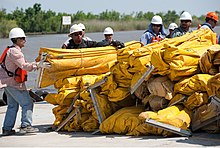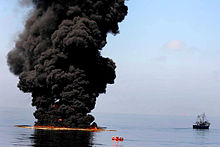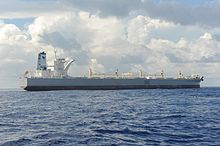Talk:Deepwater Horizon oil spill/draft
Efforts to protect the coastline and marine environments[edit]

The fundamental strategies for addressing the spill were containment, dispersal and removal. In summer 2010, approximately 47,000 people and 7,000 vessels were involved in the project. By 3 October 2012, federal response costs amounted to $850 million, mostly reimbursed by BP. As of January 2013, 935 personnel were still involved. By that time cleanup had cost BP over $14 billion.[1]
It was estimated with plus or minus 10% uncertainty that 4.9 million barrels (780,000 m3) of oil was released from the well; 4.1 million barrels (650×103 m3) of oil went into the Gulf.[2] The report led by the Department of the Interior and the NOAA said that of "75% [of oil] has been cleaned up by Man or Mother Nature", however only about 25% of released oil was collected or removed while about 75% of oil remained in the environment in one form or another.[3] In 2012, Markus Huettel, a benthic ecologist at FSU, maintained that while much of BP's oil was degraded or evaporated, at least 60% remains unaccounted for.[4]
Containment[edit]

Containment booms stretching over 4,200,000 feet (1,300 km) were deployed, either to corral the oil or as a barrier to protect a marsh, mangrove, shrimp/crab/oyster ranch or other ecologically sensitive area. Booms extend 18–48 inches (0.46–1.22 m) above and below the water surface and were effective only in relatively calm and slow-moving waters. Including one-time use sorbent booms, a total of 13,300,000 feet (4,100 km) of booms were deployed.[5] Booms were criticized for washing up on the shore with the oil, allowing oil to escape above or below the boom and for ineffectiveness in more than three to four foot waves.[6][7] [8]
The Louisiana barrier island plan was developed to construct barrier islands to protect the coast of Louisiana. The plan was criticised for its expense and poor results.[9][10] Critics allege that the decision to pursue the project was political with little scientific input.[11] The EPA expressed concern that the berms would threaten wildlife.[12]
Dispersal[edit]

The spill was also notable for the volume of Corexit oil dispersant used and for application methods that were "purely experimental".[5] Altogether, 1.84 million US gallons (7,000 m3) of dispersants were used; of this 771,000 US gallons (2,920 m3) were released at the wellhead.[13] Subsea injection had never previously been tried but due to the spill's unprecedented nature BP together with USCG and EPA decided to use it.[14] Over 400 sorties were flown to release the product.[5] Although usage of dispersants was described as "the most effective and fast moving tool for minimizing shoreline impact",[5] the approach continues to be investigated.[15][16][17]
A 2011 analysis conducted by Earthjustice and Toxipedia showed that the dispersant could contain cancer-causing agents, hazardous toxins and endocrine-disrupting chemicals.[18] Environmental scientists expressed concerns that the dispersants add to the toxicity of a spill, increasing the threat to sea turtles and bluefin tuna. The dangers are even greater when poured into the source of a spill, because they are picked up by the current and wash through the Gulf.[19] According to BP and federal officials dispersant use stopped after the cap was in place; however, marine toxicologist Riki Ott claimed that dispersant use continued after that date.[20][21][22]
Corexit EC9500A and Corexit EC9527A were the principal variants.[23] The two formulations are neither the least toxic, nor the most effective, among EPA's approved dispersants but BP said it chose to use Corexit because it was available the week of the rig explosion.[24][24][25] On 19 May, the EPA gave BP 24 hours to choose less toxic alternatives to Corexit from the National Contingency Plan Product Schedule and begin applying them within 72 hours of EPA approval or provide a detailed reasoning why no approved products met the standards.[26][27] On 20 May, BP determined that none of the alternative products met all three criteria of availability, non-toxicity and effectiveness.[28] On 24 May, EPA Administrator Lisa Jackson ordered EPA to conduct its own evaluation of alternatives and ordered BP to reduce dispersant use.[29][30] BP reduced Corexit use by 25,689 to 23,250 US gallons (97,240 to 88,010 L; 21,391 to 19,360 imp gal) per day, a 9% decline.[31] On 2 August 2010, the EPA said dispersants did no more harm to the environment than the oil itself and that they stopped a large amount of oil from reaching the coast by breaking it down faster.[20] However, some independent scientists and EPA's own experts continue to voice concerns about the approach.[32]
Underwater injection of Corexit into the leak may have created the oil plumes discovered below the surface.[25] Because the dispersants were applied at depth, much of the oil never rose to the surface.[33] One plume was 22 miles (35 km) long, more than a mile wide and 650 feet (200 m) tall.[34] In a major study on the plume, experts found the most worrisome part to be the slow pace at which the oil was breaking down in the cold, 40 °F (4 °C) water at depths of 3,000 feet (910 m).[35]
Removal[edit]


The three basic approaches for removing the oil from the water were: combustion, offshore filtration and collection for later processing. USCG said 33 million US gallons (120,000 m3) of tainted water was recovered, including 5 million US gallons (19,000 m3) of oil. BP said 826,800 barrels (131,450 m3) had been recovered or flared.[36] It is calculated that about 5% of leaked oil was burned at the surface and 3% was skimmed.[3] On the most demanding day 47,849 people were assigned on the response works.[37]
From April to mid-July 2010 411 controlled in-situ fires remediated approximately 265,000 barrels (11,100,000 US gal; 42,100 m3).[5] The fires released small amounts of toxins, including cancer-causing dioxins. According to EPA's report the released amount is not enough to pose an added cancer risk to workers and coastal residents, while a second research team concluded that there was only a small added risk.[38]
Oil was collected from water by using skimmers. In total 2,063 various skimmers were used.[37] For offshore, more than 60 open-water skimmers were deployed, including 12 purpose-built vehicles.[5] EPA regulations prohibited skimmers that left more than 15 parts per million (ppm) of oil in the water. Many large-scale skimmers exceeded the limit.[39] Due to use of Corexit the oil was too dispersed to collect, according to a spokesperson for shipowner TMT.[40] In mid June 2010, BP ordered 32 machines that separate oil and water, with each machine capable of extracting up to 2,000 barrels per day (320 m3/d).[41][42] After one week of testing, BP began to proceed[43] and by 28 June, had removed 890,000 barrels (141,000 m3).[44]
After the well was captured, the cleanup of shore became the main task of the response works. Two main type of affected coast were sandy beaches and marshes. On beaches the main techniques were sifting sand, removing tar balls and digging out tar mats manually or by using mechanical devices.[37] For marshes techniques like vacuum and pumping, low-pressure flush, vegetation cutting, and bioremediation were used.[5]
Digestion[edit]
Dispersants are said to facilitate the digestion of the oil by microbes. Mixing dispersants with oil at the wellhead would keep some oil below the surface and in theory, allow microbes to digest the oil before it reached the surface. Various risks were identified and evaluated, in particular that an increase in microbial activity might reduce subsea oxygen levels, threatening fish and other animals.[45]
Several studies suggest that microbes successfully consumed part of the oil.[1][46] By mid-September, other research claimed that microbes mainly digested natural gas rather than oil.[47] David L. Valentine, a professor of microbial geochemistry at UC Santa Barbara, said that their oil-gobbling properties had been grossly overstated.[48]
Some experts suggested that the bacteria may have caused health issues for Gulf residents, such as an outbreak of skin rashes. Genetically modified Alcanivorax borkumensis was added to the waters to speed digestion.[48][49]
References[edit]
- ^ a b Ramseur, Jonathan L.; Hagerty, Curry L. (31 January 2013). Deepwater Horizon Oil Spill: Recent Activities and Ongoing Developments (PDF) (Report). CRS Report for Congress. Congressional Research Service. R42942. Retrieved 13 February 2013.
- ^ Suzanne Goldenberg, US environment correspondent (19 August 2010). "BP oil spill: US scientist retracts assurances over success of cleanup | Environment". The Guardian. Retrieved 2010-09-05.
- ^ a b Richard A. Kerr (13 August 2010). "A Lot of Oil on the Loose, Not So Much to Be Found". Science. 329 (5993): 734. Bibcode:2010Sci...329..734K. doi:10.1126/science.329.5993.734. PMID 20705818.
{{cite journal}}: More than one of|pages=and|page=specified (help) - ^ Tar Balls from BP Oil Spill Wash Up on Gulf Beaches
- ^ a b c d e f g Butler, J. Steven (3 March 2011). BP Macondo Well Incident. U.S. Gulf of Mexico. Pollution Containment and Remediation Efforts (PDF). Lillehammer Energy Claims Conference. BDO Consulting. Retrieved 2013-02-17.
- ^ Containment boom effort comes up short in BP oil spill. The Christian Science Monitor. (11 June 2010). Retrieved 2011-04-07.
- ^ Gulf oil spill - A hole in the world | Naomi Klein | The Guardian
- ^ BP spill response plans severely flawed | MNN - Mother Nature Network
- ^ "Slosh and Berm: Building Sand Barriers off Louisiana's Coast to Hold Back Oil Spill Has Low Probability of Success" David Biello in Scientific American June 8, 2010, accessed July 19, 2010
- ^ BP Oil Spill Sand Berm Cleanup - Oil and Sand Berm Controversy - Popular Mechanics
- ^ "Sand berms partially political" article by Amy Wold in The Advocate (Louisiana) July 11, 2010, accessed July 19, 2010 [dead link]
- ^ EPA slams Jindal's sand berm plan | wwltv.com New Orleans
- ^ The Use of surface and Subsea Disperants During the BP Deewater Horizon Oil Spill. Draft (PDF) (Report). National Commission on the BP Deepwater Horizon Oil Spill and Offshore Drilling. 6 October 2010. Retrieved 2013-02-17.
- ^ Swartz, Spencer (3 September 2010). "BP Provides Lessons Learned From Gulf Spill". The Wall Street Journal. Retrieved 2010-09-05.
- ^ Oil dispersants used in Gulf of Mexico spill causing alarm | al.com
- ^ Chemicals Meant To Break Up BP Oil Spill Present New Environmental Concerns - ProPublica
- ^ Migratory Birds Carry Chemicals from BP Oil Spill to Minnesota Two Years After Disaster | Audubon Magazine Blog
- ^ Pensacola News Journal: Archives
- ^ Suzanne Goldenberg (5 May 2010). "Dispersant 'may make Deepwater Horizon oil spill more toxic' | Environment". The Guardian. Retrieved 2010-09-05.
- ^ a b Bolstad, Erika; Clark, Lesley (2 August 2010). "Government defends BP's use of dispersants, but worries linger". McClatchy Newspapers. Retrieved 2010-08-03.
- ^ (Photo credit Jerry Moran\Native Orleanian) (31 August 2010). "Degraded oil in Mississippi Sound tests positive for dispersants, says lawyer | al.com". Blog.al.com. Retrieved 2010-09-05.
- ^ "Riki Ott: An Open Letter to US EPA, Region 6". Huffington Post. Retrieved 2010-09-05.
- ^ "What are oil dispersants?]". CNN. 15 May 2010. Retrieved 2010-07-02.
- ^ a b Mark Guarino (15 May 2010). "In Gulf oil spill, how helpful – or damaging – are dispersants?". The Christian Science Monitor.
- ^ a b Mark Guarino (17 May 2010). "Gulf oil spill: Has BP 'turned corner' with siphon success?". The Christian Science Monitor.
- ^ "National Contingency Plan Product Schedule". Environmental Protection Agency. 13 May 2010. Retrieved 2010-05-21.
- ^ "Dispersant Monitoring and Assessment Directive – Addendum" (PDF). Environmental Protection Agency. 20 May 2010. Retrieved 210-05-20.
{{cite news}}: Check date values in:|accessdate=(help) - ^ Tilove (21 May 2010). "BP is sticking with its dispersant choice". Times-Picayune. Retrieved 2010-05-22.
{{cite news}}: Text "first Jonathan" ignored (help) - ^ Elisabeth Rosenthal (24 May 2010). "In Standoff With Environmental Officials, BP Stays With an Oil Spill Dispersant". The New York Times. Retrieved 2010-05-25.
- ^ Jackson, Lisa P. (24 May 2010). "Statement by EPA Administrator Lisa P. Jackson from Press Conference on Dispersant Use in the Gulf of Mexico with U.S. Coast Guard Rear Admiral Landry" (PDF). Environmental Protection Agency. Retrieved 2010-05-25.
- ^ By Ed Lavandera, CNN (3 June 2010). "Dispersants flow into Gulf in 'science experiment'". CNN. Retrieved 2010-08-02.
{{cite news}}:|author=has generic name (help) - ^ Goldenberg, Suzanne (3 August 2010). "BP oil spill: Obama administration's scientists admit alarm over chemicals". The Guardian. Retrieved 2010-08-08.
- ^ Khan, Amina (4 September 2010). "Gulf oil spill: Effects of dispersants remain a mystery". Los Angeles Times. Retrieved 2010-09-05.
- ^ "22-mile-long oily plume mapped near BP site - Disaster in the Gulf". MSNBC. 19 August 2010. Retrieved 2010-09-05.
- ^ Major Study Charts Long-Lasting Oil Plume in Gulf
- ^ Schoof, Renee (17 July 2010). "Mother Nature left to mop up oily mess". The Sun News. Retrieved 2010-07-17.
- ^ a b c On Scene Coordinator Report on Deepwater Horizon Oil Spill (PDF) (Report). September 2011. Retrieved 22 February 2013.
{{cite report}}: CS1 maint: date and year (link) - ^ Burning off oil from BP spill in Gulf posed little health risk, feds say in new report (video) | al.com
- ^ Why Is the Gulf Cleanup So Slow?, Wall St. Journal, 2 July 2010
- ^ Rioux, Paul (16 July 2010). "Giant oil skimmer 'A Whale' deemed a bust for Gulf of Mexico spill". The Times-Picayune. Retrieved 2 August 2010.
- ^ Gabbatt, Adam (16 June 2010). BP oil spill: Kevin Costner's oil-water separation machines help with clean-up. The Guardian.
- ^ Fountain, Henry (24 June 2010). "Advances in Oil Spill Cleanup Lag Since Valdez". The New York Times. Retrieved 2010-07-05.
- ^ Clarke, Sanchez, Bonfiles, Escobedo (15 June 2010). "BP 'Excited' Over Kevin Costner's Oil Cleanup Machine, Purchases 32". ABC News Good Morning America.
- ^ "Gulf of Mexico Oil Spill Response: Current Operations as of June 28". Deep Water Horizon Unified Command Agency. 28 June 2010. Retrieved 2010-06-28.[dead link]
- ^ Eli Kintisch (13 August 2010). "An Audacious Decision in Crisis Gets Cautious Praise". Science. 329 (5993): 735. Bibcode:2010Sci...329..735K. doi:10.1126/science.329.5993.735. PMID 20705819.
{{cite journal}}: More than one of|pages=and|page=specified (help) - ^ Cite error: The named reference
valentinewas invoked but never defined (see the help page). - ^ Brown, Eryn (16 September 2010). "Bacteria in the gulf mostly digested gas, not oil, study finds". Los Angeles Times.
- ^ a b Oil-eating microbes may not be all they’re cracked up to be | The Upshot Yahoo! News. Yahoo!! News. Retrieved 2011-04-07.
- ^ Riki Ott: Bio-Remediation or Bio-Hazard? Dispersants, Bacteria and Illness in the Gulf. Huffington Post. Retrieved 2011-04-07.
Cite error: A list-defined reference named "usatoday161210" is not used in the content (see the help page).
Cite error: A list-defined reference named "AutoBB-100" is not used in the content (see the help page).
Cite error: A list-defined reference named "AutoBB-101" is not used in the content (see the help page).
Cite error: A list-defined reference named "VOA2010-05-04" is not used in the content (see the help page).
Cite error: A list-defined reference named "AutoBB-103" is not used in the content (see the help page).
Cite error: A list-defined reference named "CITEREFbp2010a" is not used in the content (see the help page).
Cite error: A list-defined reference named "CITEREFwapo2010a" is not used in the content (see the help page).
Cite error: A list-defined reference named "booms deployed april 30" is not used in the content (see the help page).
Cite error: A list-defined reference named "AutoBB-117" is not used in the content (see the help page).
Cite error: A list-defined reference named "AutoBB-118" is not used in the content (see the help page).
Cite error: A list-defined reference named "nyt090610" is not used in the content (see the help page).
Cite error: A list-defined reference named "C130" is not used in the content (see the help page).
Cite error: A list-defined reference named "AutoBB-121" is not used in the content (see the help page).
Cite error: A list-defined reference named "AutoBB-122" is not used in the content (see the help page).
Cite error: A list-defined reference named "Material Safety Data Sheet" is not used in the content (see the help page).
Cite error: A list-defined reference named "AutoBB-123" is not used in the content (see the help page).
Cite error: A list-defined reference named "AutoBB-124" is not used in the content (see the help page).
Cite error: A list-defined reference named "AutoBB-125" is not used in the content (see the help page).
Cite error: A list-defined reference named "AutoBB-126" is not used in the content (see the help page).
Cite error: A list-defined reference named "AutoBB-128" is not used in the content (see the help page).
Cite error: A list-defined reference named "AutoBB-132" is not used in the content (see the help page).
Cite error: A list-defined reference named "AutoBB-137" is not used in the content (see the help page).
Cite error: A list-defined reference named "msnbc301112" is not used in the content (see the help page).
Cite error: A list-defined reference named "AutoBB-140" is not used in the content (see the help page).
Cite error: A list-defined reference named "oilgas" is not used in the content (see the help page).
Cite error: A list-defined reference named "AutoBB-145" is not used in the content (see the help page).
Cite error: A list-defined reference named "McN" is not used in the content (see the help page).
Cite error: A list-defined reference named "AutoBB-146" is not used in the content (see the help page).
Cite error: A list-defined reference named "AutoBB-147" is not used in the content (see the help page).
Cite error: A list-defined reference named "AutoBB-150" is not used in the content (see the help page).
Cite error: A list-defined reference named "AutoBB-152" is not used in the content (see the help page).
Cite error: A list-defined reference named "gillis" is not used in the content (see the help page).
Cite error: A list-defined reference named "AutoBB-155" is not used in the content (see the help page).
Cite error: A list-defined reference named "AutoBB-156" is not used in the content (see the help page).
Cite error: A list-defined reference named "AutoBB-157" is not used in the content (see the help page).
